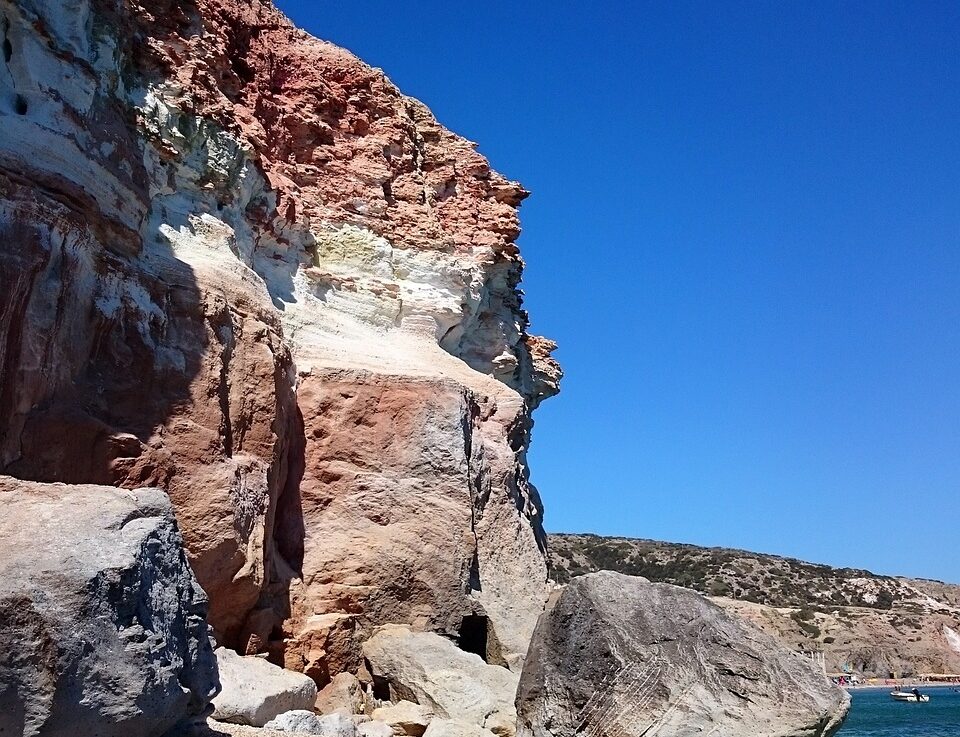Milos, one of the most stunning islands in the Cyclades, is renowned for its breathtaking landscapes, crystal-clear waters, and rich history. However, one aspect of the island that often surprises visitors is the occasional whiff of sulfur in the air. If you’re planning a trip to Milos, here’s what you need to know about this sulfuric scent and why it’s actually a fascinating part of the island’s natural charm.
The Origin of the Sulfur Smell
1. Volcanic Activity
- Geological Background: Milos, like many of the Aegean islands, has a volcanic origin. The island is part of the Hellenic Volcanic Arc, and its unique landscape is a testament to this fiery past. The sulfur smell that you might notice in certain areas is directly related to this ongoing volcanic activity.
- Hydrothermal Vents: The sulfuric odor primarily comes from hydrothermal vents, where sulfur gases are released from beneath the Earth’s surface. These vents are remnants of the island’s volcanic history and are still active, particularly around specific locations known for their geothermal activity.
2. Natural Hot Springs
- Therapeutic Waters: Milos is home to several natural hot springs that are rich in minerals, including sulfur. These springs have been renowned for their healing properties, particularly for skin conditions and respiratory issues.
- Popular Spots: You can experience these sulfur-rich waters at places like Palaiochori Beach and Kanava Hot Springs. While the smell can be strong, many visitors find it to be a small inconvenience compared to the therapeutic benefits of soaking in these natural baths.
Where You’ll Notice the Smell
1. Beaches
- Palaiochori Beach: One of the most famous beaches on the island, Palaiochori Beach is known for its warm, sulfur-scented waters. The colorful cliffs surrounding the beach are a visual reminder of the island’s volcanic nature.
- Sarakiniko Beach: Although Sarakiniko is more famous for its otherworldly white rock formations, the area occasionally carries a faint sulfur smell due to its volcanic origins.
2. Caves and Mines
- Sulfur Mines: On the southeastern coast of Milos, you’ll find the abandoned Sulfur Mines at Thiorichia. Once a bustling industrial site, the mines now stand as a historical relic where the smell of sulfur lingers as a reminder of the island’s mining past.
3. Hot Springs
- Kanava Hot Springs: Located near the village of Adamas, these springs are another place where you can catch the distinct smell of sulfur. The hot springs are less crowded, offering a more secluded and authentic experience.
4. Pera Triovasalos
- Geothermal Activity: Pera Triovasalos is another area on Milos where the sulfur smell is noticeable. The village is situated near several geothermal spots, where the scent of sulfur permeates the air, reminding visitors of the island’s volcanic activity beneath the surface.
Embracing the Sulfur Smell: A Part of Milos’ Charm
A Sign of Natural Beauty
- Unspoiled Nature: The sulfur smell on Milos is a sign of the island’s untamed natural beauty and a direct connection to its volcanic origins. It adds to the island’s unique and mysterious allure. Milos used to be one of the largest exporters in the world for sulfur.
Health Benefits
- Therapeutic Experience: Many visitors seek out the sulfur-rich hot springs for their healing properties. Whether soaking in these mineral waters or simply enjoying the view, you’re engaging with the island’s volcanic history in a deeply personal way.
A Memorable Experience
- Unique Atmosphere: The sulfur scent might be unexpected, but it’s part of the sensory experience that makes Milos so memorable. It’s a distinctive element that will remind you that you’re exploring a place shaped by powerful natural forces.
Tips for Enjoying Milos Despite the Smell (You Probably Won’t Notice It)
Do Your Research: Make sure when booking a hotel or restaurant, that there is not essence of sulfur in the air OR IN THE FOOD! Most places don’t have any issues, but you don’t want to stumble on the places where sulfur is abundant, especially in the water supply. Imagine trying to get clean with a sulfur smell in the air!
Stay Upwind: When exploring areas known for their strong sulfur smell, try to position yourself upwind to minimize your exposure to the odor.
Embrace the Experience: Instead of being put off by the smell, embrace it as part of the island’s character. It’s a small trade-off for the stunning natural beauty and historical intrigue Milos offers.
Time Your Visits: Visit the sulfur-heavy areas during times when the scent is less intense, usually earlier in the day or on breezy days when the smell is dispersed. You probably won’t notice it in general!
Milos is a breathtaking island with a rich geological history that continues to shape its landscape and atmosphere. The occasional sulfur smell is a natural reminder of the island’s volcanic origins, adding a unique element to your travel experience. Instead of avoiding it, consider it a part of what makes Milos special—a reminder that you’re exploring a place where nature’s raw power is still very much alive. So, take a deep breath (when the wind is in your favor) and enjoy all that Milos has to offer!









